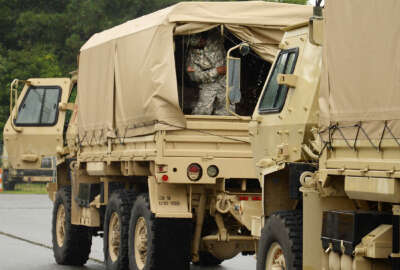
National Guard facing training dilemma as new study shows where force is bending
The National Guard is looking to commanders to deal with burdensome training requirements.
Subscribe to Federal Drive’s daily audio interviews on iTunes or PodcastOne
The Army National Guard has increased its training days over the past years to deal with operational and readiness demands.
Leadership wants to push the Guard, but not break it, said Guard Command Sgt. Maj. Christopher Kepner during an Oct. 10 speech at an Association of the United States Army event in Washington.
But the Army is finding cracks in the force around the issue of ancillary training.
The National Guard recently conducted a “Pulse of the Force” study and the results were loud and clear.
“Our senior enlisted say the things that are pushing the force too hard are the ancillary training requirements, the 100 percent resiliency training, the cyber awareness training. All the stuff that takes away from building lethality,” Kepner said.
The Air Guard also picked ancillary training as its number one issue for the force.
The study polled 50 senior enlisted personnel. Kepner said one respondent stated “computer screens have taken the place of leaders. My job is making sure soldiers get to the right auditorium at the right time.”
Kepner said the study, along with a report on it, was sent to the defense secretary and the chief of staff of the Army.
The solution isn’t as easy as cutting training, however.
The Army has already significantly reduced the amount of required training, said Sgt. Maj. of the Army Daniel Daily.
“When you really start peeling back the onion almost everyone in here, when you look at those tasks, will say, ‘Well, we’ve got to do that [training],” Daily said. “What has increased is the complexity of war, the complexity of the environment in which we live in and the demands of the noncommissioned officer and our soldiers are greater than they ever have been in history … there’s not enough time. I don’t think we’re going to get enough time to where we will say, ‘OK commander, here is your white space.’ That’s not happening anytime soon.”
The Guard is stuck in a dilemma of prioritizing the training it can do while working in an environment that requires rigid quotas on the percentage of guardsmen who complete training.
The National Guard asks its member to train at least 39 days a year, but that minimum is far from a standard.
In the last year, the Guard increased training days for armored and Stryker units, which go to the National Training Center in Southern California. The training is now a four-year strategy of 39 days in year one, 48.5 days in year two, 60 days in year three and 51 days in year four.
With training already stretching guardsmen’s time thin, the question is what the service fits into the finite time guardsmen have to train and what should be left out when time runs out?
Daily and Kepner said that decision should be up to the commander in charge, but that commander has to accept the risk.
No one doubts the importance of suicide prevention training. In fact, a 2012 study of Army Master Resilience Training designed by University of Pennsylvania behavior specialists found the training improved the psychological health of soldiers.
At the same time, if soldiers aren’t prepared for war, the Army will be dooming them to failure when they are deployed.
Kepner said the Army needs to be less risk averse, to change its culture and force its commanders to make the hard decisions of what training won’t make it into the curriculum and deal with the consequences.
“It’s the ability to articulate what is not going to be done. If it falls out of building lethality or building ready forces, then the next higher commander has to take that risk,” Kepner told Federal News Radio after the speech. “We’ve got to incentivize risk takers who take calculated, measureable risk, understanding the risk and the benefit of it and we have to empower them.”
Kepner said that attitude is starting at the top, but it needs to permeate down to the tactical level.
Of course, the National Guard is trying other ways to cut training hours. The Guard is transitioning some courses to online courses and streamlining classes.
Kepner said everything is on the table.
Copyright © 2025 Federal News Network. All rights reserved. This website is not intended for users located within the European Economic Area.
Scott Maucione is a defense reporter for Federal News Network and reports on human capital, workforce and the Defense Department at-large.
Follow @smaucioneWFED





